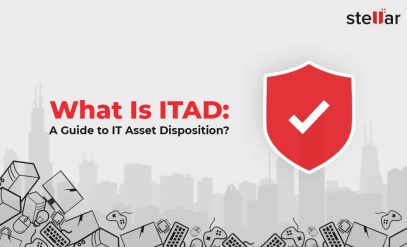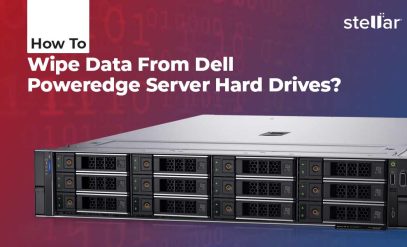| Summary: Data centers play a crucial role in storing and processing vast amounts of information. However, as equipment grows old, data center decommissioning becomes inevitable. Learn more about BitRaser Drive Eraser, which ensures secure data erasure. |
|---|
As with any piece of equipment, data centers require regular updates. When your servers reach the end of their lifecycle, data center decommissioning becomes necessary.
Even if the servers are functioning, there are potential advantages when you upgrade.
Upgrading server infrastructure offers significant benefits, bringing in new technology solutions that meet customer demands and improve organizational capabilities. However, before embarking on equipment upgrades, proper data center decommissioning is imperative.
In this article, we will discuss:
- Why decommissioning outdated servers is essential
- Steps for data center decommissioning
- BitRaser – The best solution for data center decommissioning
Why Data Center Decommissioning is Necessary
Data center decommissioning allows organizations to adapt to changing needs. Modern servers are powerful machines that can handle complex processes, such as hosting websites and managing databases. They are also highly scalable.
Data center decommissioning is necessary for several reasons:
1. Better technology
Decommissioning allows for the removal of outdated equipment and systems that are no longer capable of meeting the growing demands. New servers bring better CPUs and hard drives that can retrieve data faster
2. Cost cutting
Decommissioning older data center equipment can help organizations reduce costs. Since older servers tend to be less energy-efficient, an upgrade every few years is necessary.
3. Space saving
Data centers require physical space to house servers and networking equipment. Data center decommissioning frees up space for servers with more capacity.
Also Read: IT Asset Disposal and the Importance of Secure Chain of Custody
7 Essential Steps for Data Center Decommissioning
Data center decommissioning is a complex process. A typical data center can have hundreds of servers running in tandem.
It is no easy task to ensure the safe and secure disposal or relocation of data center equipment. Here are the typical steps involved in a data center decommissioning process:
1. Planning and Assessment
You need to conduct a comprehensive assessment of the current data center infrastructure, including equipment, cabling, power, cooling, and connectivity.
Identify any legal requirements that need to be considered – such as legal order to preserve a particular hard drive intact since it has evidence of cybercrime.
2. Data Backup
Preservation of data by performing a thorough data backup is critical. All necessary data and applications are migrated to alternative data centers and cloud platforms. Later it would be copied back to the new infrastructure.
Verify the successful transfer and accessibility of the data.
3. Inventory Management
Create a detailed inventory of all equipment present in the data center.
These include:
- Servers
- Network switches
- Hard drives
- Cables
- Networking devices
Document the condition, and specifications, of each asset. Determine how each asset class will be disposed of. They may be reused, resold, recycled, or disposed of.
4. Decommissioning and Removal
Begin the actual decommissioning process by disconnecting all equipment. Follow proper shutdown procedures to avoid any damage.
Uninstall and remove servers from racks, detach cooling systems, and unplug cables and networking equipment.
Adhere to proper practices to avoid damage during the removal process.
5. Cable Management
Data centers have miles of cables. Remove and dispose of all cabling within the data center, including network cables, power cords, and fiber optic cables.
Ensure that cable routes are properly documented for future reference. Dispose of cables in an environmentally responsible manner, following regulations and recycling guidelines.
6. Environmental Considerations
Evaluate the environmental impact associated with the decommissioning process.
Properly dispose of electronic waste, such as old routers and switches, by recycling or donating them to certified organizations. Consider energy-efficient and environmentally friendly alternatives for equipment disposal or reuse.
7. Documentation and Reporting
Maintain accurate records throughout the decommissioning process. Document the inventory lists, disposal certificates, data erasure reports, and any other relevant information.
Prepare a final report summarizing the decommissioning activities. These records and reports serve as valuable documentation for compliance.
BitRaser – Erase Data With 100% Confidence
BitRaser Drive Eraser is a software application designed and developed by Stellar Data Recovery.
Our software provides peace of mind when it comes to data center decommissioning. Not only does BitRaser Drive Eraser prioritize security, but it also ensures compliance with industry regulations.
Features of BitRaser Drive Eraser:
- Compliant with 24 international standards including NIST 800-88, US – DoD 5220.22-M, and British HMG IS5.
- Meets the requirements of data protection regulations such as the GDPR and HIPAA.
- Secure erasure from hard drives in PC, laptops, and rack-mounted servers.
- Can access and delete hidden areas of hard drives such as HPA and DCO.
- Offers support for all major interfaces such as PATA, SATA, NVMe, SCSI, and FireWire.
- BitRaser Drive Eraser can generate detailed reports that track the erasure of data.
- Generates tamper-proof certificates of data erasure that can help comply with data protection regulations such as EU GDPR, SOX, GLBA, HIPAA, etc.
- integrate with a cloud console for centralized reporting and management.
At Stellar, we pride ourselves not only on our cutting-edge software but also on our exceptional customer support. Our dedicated team is always ready to assist you with any questions or concerns you may have.
Frequently Asked Questions
1. What is a data erasure algorithm?
A data erasure algorithm or data erasure standard is used to overwrite data on storage devices to make it irretrievable. These algorithms determine how data is overwritten and the patterns used during the erasure process.
For example, DoD 5220.22-M was developed by the U.S. Department of Defense. In the first pass, it writes a binary 0, followed by binary 1, and finally by a random ASCII character. With BitRaser you can even create a custom algorithm and the software will execute it.
2. What is a bootable USB used for?
Every computing system has a system partition that hosts the OS files. In Windows, it is the C partition. In MacOS it is called Macintosh HD.
If you are deleting a hard drive, you cannot access this partition. The data erasure software cannot erase itself or the systems files that help it run.
Hence for 100% deletion, you need to boot the computer from another drive. The easiest way to do this is to use a bootable USB drive. BitRaser can be run from a bootable USB drive. All you need is the ISO file from our site.
3. How many drives does BitRaser wipe at the same time?
BitRaser can erase up to 32 drives at the same time and 65K network-connected drives. Our software works very fast, erasing a GB of data every few seconds. We have optimized the parameters for quick wiping.
Of course, it also depends on the algorithm you desire to use.
A zero fill is faster than using a multipass algorithm. You can reset all sectors using a binary zero if you want to erase hundreds of drives quickly. The more the number of passes, like DoD 5220.22-M 7 pass, the greater the time taken.
Note that the latest version of NIST 800-88 considers a single zero pass to be effective data erasure.







